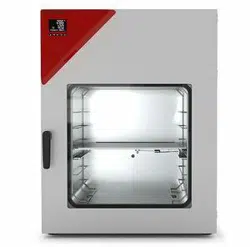Loading ...
Loading ...
Loading ...

VD (E3.1) 10/2020 page 25/179
Do not install or operate the chamber in potentially explosive areas.
DANGER
Danger of explosion due to combustible dusts or explosive mixtures in the vicinity
of the chamber.
Serious injury or death from burns and / or explosion pressure.
∅ Do NOT operate the chamber in potentially explosive areas.
KEEP explosive dust or air-solvent mixtures AWAY from the vicinity of the chamber.
Ambient conditions
• Permissible ambient temperature range during operation: +18 °C / 64°F to +32 °C / 90°F.
The ambient temperature should not be substantially higher than the indicated ambient
temperature of 22 °C +/- 3 °C to which the specified technical data relate. Deviations from the
indicated data are possible for other ambient conditions.
• Permissible ambient humidity: 70 % r.h. max., non-condensing.
• Installation height: max. 2000 m / 6562 ft above sea level.
Minimum distances
• Distance between several chambers of the same size: 250 mm / 9.8 in
• Wall distances to rear: 100 mm / 3.9 in
• Lateral wall distances: 70 mm / 2.76 in
• Spacing above and behind the chamber: 100 mm / 3.9 in.
NOTICE
Danger by stacking.
Damage to the chambers.
∅ Do NOT place the chambers on top of each other.
Other requirements
To completely separate the chamber from the power supply, you must disconnect the power plug. Install
the chamber in a way that the power plug is easily accessible and can be easily pulled in case of danger
or to turn off the chamber.
The maximum permissible ambient temperature of the vacuum pumps supplied by BINDER is 40 °C /
104 °F.
Notes when using inert gas:
When operating the VD vacuum drying oven with inert gas, correctly follow the technical ventilation
measures, as described in the DGUV guidelines 213-850 on safe working in laboratories, issued by the
employers’ liability insurance association (for Germany).
For operation with inert gas, the chamber is supplied with an oxygen-displacing gas, e.g. N
2
. Inert gases
in high concentrations are hazardous to health. They are colorless and almost odorless and therefore
practically imperceptible. Inhalation of inert gases can cause drowsiness up to respiratory arrest. When
the O
2
content of the air decreases below 18%, there is risk of death from lack of oxygen. Any gas that
might escape has to be led out via good room ventilation or a suitable exhaust system.
Loading ...
Loading ...
Loading ...
